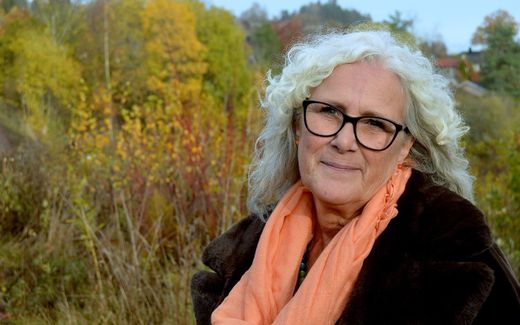Church struggles to include people with disability

Martina Köninger from the European Disability Network. She propagates a better accessibility of churches for disabled people. "A welcoming attitude is the most important." Photo CNE.news, Evert van Vlastuin
European Union
To enter the sanctuary with her wheelchair is a struggle for Martina Köninger (54). But the uncomfortable looks of fellow Christians are even more difficult to swallow.
To attend a church service, Köninger, who comes from Hamburg, Germany, has to be lifted with her wheelchair and carried down the stairs. There is no elevator. She cannot go to the restroom either when she is in the church because her wheelchair does not fit in the small space of the ladies' bathroom.
This Saturday is the International Day of Persons with Disabilities. On that day, extra attention is paid to the problems that this group of people encounters. "Only after I got in a wheelchair I realised that churches are not adjusted to people with a disability", Köninger says. The inconveniences these people encounter are not related to the church building but also to the churchgoers.
More than thirty years ago, Köninger got into a car accident on her way to the stores. She collided with two other vehicles. She was seriously injured and brought to the hospital. There, she stayed for a month in the intensive care unit. After her dismissal from the hospital, she has never been able to walk again because her spine is permanently damaged.
Nowadays, she is active as a member of the steering group of the European Disability network. In that position, she attempts to convince churches and their members of the importance of "inclusivity." And she books success: her congregation's church building now has an elevator.
Communication
A disability is a mental or physical condition that hinders people's participation in activities or communication with others, Köninger explains. According to her, one in seven people has to deal with such a condition. She bases these numbers on recent statistics from the World Health Organisation.
At the same time, she notices that the number of people with a disability is much lower in the church. Research from the organisation Church Mission Society speaks about one in ten people. Why are there fewer people with a disability in church than in society? Disabled people may not dare to come to church. They fear being excluded, Köninger explains.
Tips and tricks to make your church more inclusive
A church should be accessible for all, Martina Köninger of the Disability network Europe argues. She has some suggestions for churches to welcome everyone.
Concerning physical changes to the building: Ensure broad hallways, access to a disability restroom and an elevator. Make the stage accessible for wheelchair users.
Set up a central point where people can go to if they have problems with the accessibility of the church.
Talk to disabled people and ask them what they need. Find a solution together.
Make sure that the accessibility of the church is clear. Publish pictograms on the website to show that the building is accessible for wheelchairs, that there are accommodations for people with hearing problems and that people with bad eyesight can read texts in larger letters.
The previous point also applies to specific activities. For example, write on invitations for missionary activities that they are accessible for disabled people too. That lowers the threshold of joining for this target group.
Organise special activities for people with a disability. For example, make sure that one of the activities during a summer camp is especially for this group of people.
Invite a sign language interpreter who can translate the spoken text for people with hearing problems.
And that fear is not only based on the lack of an elevator, bad acoustics that hinder deaf people from listening to the sermon or dangerous thresholds over which blind people may stumble. The most significant obstacle for Christians with a disability is the attitude of their fellow believers, Köninger points out. From experience, she knows that other church people do not always know what to say or to do when they encounter someone with a disability in the hall of the church. The first time she came to church after her accident, she experienced how her wheelchair made people uncomfortable. "They did not know anymore how to talk to me and would rather avoid me."
In addition, she noticed that people connected a wheelchair automatically to a mental handicap. "They adjusted their level of conversation and approached me in a childish way."
Also, parents of children with a disability experience the discomfort of churchgoers. Sometimes they even feel resistance against their children. "Statistics of the international Christian network Lausanne show that up to 90 per cent of these parents feels unwelcome in church. Churchgoers are prone to seeing these children as a nuisance during the church service."
Intelligence
Partially, this is a result of the view on man both in the church and in society. That is based on the average, healthy person, Anthonij Rietman says. He used to be a policy officer of ethics and identity for the Dutch organisation Filadelfia in the Dutch city of Rotterdam. "People see themselves as the starting point. Thus, church life is adapted to people with average intelligence and health."
The reformed tradition holds onto a vision that sees man as a reasonable and moral being. "That is a one-sided interpretation of the doctrine that man was created after God's image", says Rietman, who studied theology.
That often-unconscious view of man has significant implications, the theologian says. "That vision does no right to people with a mental illness. If you describe a human being as a being with whom you can communicate, how would you value the simple-minded? Would they not be human beings?"
Rietman fears that most people are not very engaged with people with a disability, nor with the parents of such people. "I grew up with two younger sisters who have a double handicap. You then notice over the years that there is much indifference in the congregation. Many Christians do not show affinity with their handicapped neighbour, even though that should be connected closely to life in the communion with Christ."
The attitude of Christians towards disabled people should change, Rietman argues. "Christ accepts sinners without there being any reason in them. That way, we must accept our handicapped neighbours unconditionally. Listen attentively to their stories and take them seriously. They, too, are created after God's image. That is the basis for everyone's dignity. No one is less than the other. Also, members with a disability are part of the body of Christ. It is for a reason that Jesus says: "As far as you do something good for the least of My brothers, you do it for Me."
Preachers
God glorifies what is small and lowly, Rietman wrote earlier in an article called "Aanschouwt de leliën" (Look at the lilies). In that article, he refers to the song of Mary. According to him, the Magnificat shows clearly that God chose the "insignificant of this world and the despised." Rietman says, therefore, that it is important that preachers show this to their congregation. "We must look critically at ourselves and the congregation as the body of Christ. For example, do we pray enough for each other?"
Martina Köninger from the Disability Network says that pastors should give churchgoers tips and suggestions on how to deal with disabled people. "We want to be seen as normal. Of course, some matters must be adjusted so we can join the congregation. But it should not be strange to have a disability. As long as we are here on earth, it will be normal to live with disabilities."
Inclusive church needs creative architect
With a bit of creativity, many church buildings can be made more accessible, Herman Bakker says. He is an architect and works for the Dutch company Van Hoogevest Architecten in the town of Amersfoort. There, he designs churches but also restores historical buildings. "I find it self-evident that churches are accessible for everyone, regardless of disability."
Bakker finds it essential that disabled people are as much part of the church as any other member. "I find it bad if someone in a wheelchair always has to sit in the aisle. That problem can be solved by making some rows of chairs a bit shorter so the wheelchair can be parked next to it without standing out."
Furthermore, the architect pays attention to the space wheelchairs need to make a turn. "We ensure that the restrooms for people with a disability are so large that wheelchairs can turn in a circle of 1.5 metres. The same applies to aisles. These measurements are specified by law."
For people who are easily overstimulated, the architect looks, where possible, at the spaciousness of a building, the possibility of sitting somewhat separated from the congregation and how the acoustics function in a sanctuary. For example, overstimulation can be partly prevented if the pews or chairs are further apart so people do not sit too close together. To regulate the acoustics in the church, Bakker can use sound-absorbing materials to somewhat lessen the echo in the sanctuary, for example.
In historic churches, improving accessibility often requires a bit more creativity, says Bakker. Because those churches contain monumental elements, not everything can be adapted just like that. "We can't just build in an accessible toilet. We have to find a suitable space for that in the building," says the architect.
Once, Bakker wanted to make the fenced-in baptismal garden of a historic church building accessible to wheelchair users by creating an opening in the fencing. In such a case, he must receive permission from the civil municipality and the National Institute of Cultural Heritage, "the guardians of listed buildings".
An architect does not always get that space. That's when creative thinking plays a role. "We are not always allowed to take historical pews from a church building because they are not at ground level and therefore not accessible to the disabled. Then we look to see if people with mobility problems can sit somewhere else."
Related Articles






